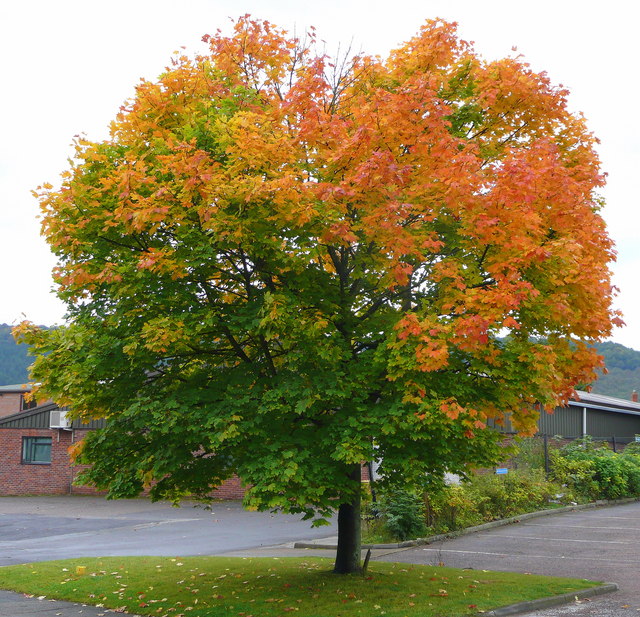This is the second half of a two-part series on Norway maple. The following examines the tree’s flowers, fruit, seed production, propagation, soil & topography, root development, damaging agents and pests, allergenic potential, cultivation, and uses.
Introduction
Norway maple (Acer platanoides), also referred to as Bosnian maple and plane maple, is a deciduous tree that is native to eastern and central Europe, and western Asia. It was introduced to North America as a shade tree in the mid 1700s. It has since become widespread throughout North America, particularly the United States.
Norway maple belongs to the family Sapindaceae. It is known for its dense canopy and striking red or purple foliage. In its native territory, Norway maple is seldom a dominant species, usually growing as an understory tree. In parts of North America, it has been designated an invasive tree species. It is commonly selected as a planting in urban and suburban areas.
Flowers
Norway maple displays yellow to yellow-green flowers in early spring, just prior to budburst. In cooler areas, flowering may be delayed until June. The flowers form in corymbs. Each corymb consists of 15 to 40 flowers. Each flower is monoecious.
Fruit
The fruit are paired samara with two-winged seeds. The seeds are disc-shaped, and strongly flattened. They measure 10 to 15 mm wide, and around 3 mm thick. The wings are widely spread. They tend to measure 1 ¼ to 2 inches long. The samara are initially green, but turn tan as they age.
Seed Production
Norway maple produces an abundance of viable seeds. The seeds can be dispersed by birds, rodents, air currents, and splashes of rain. Once they have settled at a suitable location, the seeds rapidly germinate. Norway maples often develop in dense stands that compete with, and dominate, native plants.
Propagation
Norway maple can be propagated from seed, and through grafting. Both methods are highly effective.
Soil & Topography
Norway maple is most partial to full sun. It is adaptable to a wide range of soil types and climatic conditions, and can be easily transplanted. It can grow in infertile soil, but flourishes most in rich, organic, moist soils.
Root Development
Norway maple typically establishes a shallow root system. This allows it to compete for soil nutrients, and supplant most other trees and shrubs. Weeds and grasses seldom grow beneath Norway maples. The roots exhibit moderate resistance to salt exposure.
Damaging Agents and Pests
Young Norway maples can incur trunk injuries when subjected to severe winter storms. The stems of young Norway maples can also suffer from sun scorch damage. The tree is vulnerable to bark stripping by grey squirrels. Squirrels and wild birds feed on the seeds. When planted in alkaline soils, Norway maples may experience an iron deficiency, causing the leaves to exhibit symptoms of chlorosis.
A bevy of Lepidoptera species favor the tree’s foliage. Ectoedemia sericopeza, a moth in the family Nepticulidae, mines the seeds. The larvae emerge from eggs laid on the samaras, and tunnel into the seeds to feed on them. Aceria pseudoplatani is a mite that induces the formation of a felt gall on the underside of the leaves of sycamore and Norway maple.
While generally free of most plant diseases, Norway maple can be attacked by the powdery mildew Uncinula bicornis. The fungal pathogen Rhytisma acerinum can cause tar spots to form on the leaves. The roots of seedlings can be infected by verticillium wilt. Cristulariella depraedans can cause grey mold spots to form on the leaves. Sooty bark disease can impact Norway maple in the United States, the United Kingdom, France, and Germany. The fungal pathogen Ustulina deusta can infect Norway maples, and cause wood decay.
Allergenic Potential
Norway maple is a prolific pollen producer. As such, it has a high allergenic potential.
Cultivation
Norway maple is frequently selected for cultivation. Many cultivars have been developed that exhibit unique traits and growing habits. Some of the most popular cultivars include ‘Columnare’, ‘Crimson King’, ‘Dissectum’, ‘Drummondii’, ‘Emerald Queen’, ‘Erectum’, ‘Globosum’,‘Lorbergii’, ‘Olmsted’, ‘Princeton Gold’, ‘Summershade’, and ‘Schwedleri’.
Uses
- The wood is used in the construction of furniture, flooring, and musical instruments. It is finely-textured, and has a white coloration.
- In Europe, Norway maple is considered an ideal specimen for medium to large bonsai.
- The ‘Crimson King’ and ‘Princeton Gold’ varieties have been granted the Royal Horticultural Society’s Award of Garden Merit.
- Following its introduction to the United States, Norway maple was extensively planted as a shade and street tree.
- In Norway and Sweden, sugar is derived from the sap of Norway maple.
- Norway maple attracts pollinators and wild birds.
Additional Resources:
https://www.cabi.org/isc/datasheet/2883
Photo courtesy of Jonathan Billinger CC-by-2.0


